Performance and Parameter Sensitivity Analysis of the PEMFC Flow Channel with Porous Baffles
Abstract
:1. Introduction
2. Geometric Description
3. Establishment of Numerical Model
3.1. Model Assumptions
- (1)
- The reaction gas is the ideal gas equation;
- (2)
- The gas flow in the PEMFC is laminar flow;
- (3)
- The porosity, conductivity, and permeability of the GDL and CL is isotropic;
- (4)
- The contact resistance between the layers is ignored;
- (5)
- Gravity is ignored;
- (6)
- Only protons can pass through the proton exchange membrane;
- (7)
- The system is ideal and binary.
3.2. Governing Equations
3.3. Boundary Design
3.4. Numerical Simulation
3.5. Model Validation
3.6. Description of New Channel
4. Results and Analysis
4.1. Comparison with Two Types of Channels
4.2. Sensitivity Analysis of the New Channel Parameters
5. Conclusions
- Compared with traditional single-channel PEMFCs, the PEMFC with four porous baffles was found to be better at high current density. At 0.4 V, the average current density of the PEMFC increased by 12.8% and the maximum power density increased by 12.7%.
- Porous materials were used as baffles to improve the uniformity of the local distribution of oxygen and the concentration under the ribs where the baffles were located, thus improving the performance of the PEMFC.
- The influence of the structure parameters of the porous baffles on the performance of the PEMFC can be described as follows: as the porosity of the baffle and the number of baffles increase, the performance of the PEMFC gradually increases. With the increase in the thickness of the baffle, the performance of the PEMFC shows a trend of increasing and then decreasing, resulting in two peaks.
Author Contributions
Funding
Institutional Review Board Statement
Informed Consent Statement
Data Availability Statement
Conflicts of Interest
Nomenclature
| The porosity | |
| The density (Kg/m3) | |
| The pressure (Pa) | |
| The mass fraction of substance | |
| Two-phase conversion coefficient (1/s) | |
| The geometrical area (m2) | |
| Relative humidity | |
| Velocity (m/s) | |
| The source | |
| The potential | |
| The mole fraction of substance | |
| μ | Viscosity (Pa/s) |
| The flux (mol/(m2 s)) | |
| Subscripts | |
| The substance type, | |
| k | The substance type, |
| The computational domain, GDL or CL | |
| j | Two-phase water, liquid or gas. |
| The membrane | |
| The channel | |
| The electrolyte potential | |
| The potential | |
| a | The anode |
| The ionic water | |
| The cathode | |
| The liquid water | |
| The maximum value | |
| The condensation coefficient | |
| evap | The evaporation coefficient |
| The saturation value | |
| eff | The effective value |
| A mixture of N substances | |
References
- Wang, Y.; Chen, K.S.; Mishler, J.; Cho, S.C.; Adroher, X.C. A review of polymer electrolyte membrane fuel cells: Technology, applications, and needs on fundamental research. Appl. Energy 2011, 88, 981e1007. [Google Scholar] [CrossRef] [Green Version]
- Wilberforce, T.; Alaswad, A.; Palumbo, A.; Dassisti, M.; Olabi, A.G. Advances in stationary and portable fuel cell applications. Int. J. Hydrog. Energy 2016, 41, 16509–16522. [Google Scholar] [CrossRef] [Green Version]
- Chen, Z.; Yang, X.; Hu, X.; Wang, C. Optimization of channel structure for proton exchange membrane fuel cells based on a three-dimensional two-phase flow model. Int. J. Energy Res. 2021, 45, 8794–8809. [Google Scholar] [CrossRef]
- Wang, X.D.; Duan, Y.Y.; Yan, W.M.; Peng, X.F. Local transport phenomena and cell performance of PEM fuel cells with various serpentine flow field designs. J. Power Sources 2008, 175, 397–407. [Google Scholar] [CrossRef]
- Korkischko, I.; Carmo, B.S.; Fonseca, F.C. Shape Optimization of PEMFC Flow-channel Cross-Sections. Fuel Cells 2017, 17, 809–815. [Google Scholar] [CrossRef]
- Ferng, Y.; Su, A. A three-dimensional full-cell CFD model used to investigate the effects of different flow channel designs on PEMFC performance. Int. J. Hydrog. Energy 2007, 32, 4466–4476. [Google Scholar] [CrossRef]
- Fan, L.H.; Niu, Z.Q.; Zhang, G.B.; Jiao, K. Optimization design of the cathode flow channel for proton exchange membrane fuel cells. Energy Convers. Manag. 2018, 17, 1813–1821. [Google Scholar] [CrossRef]
- Ozdemira, S.N.; Taymaz, I. Numerical investigation of the effect of blocked gas flow field on PEM fuel cell performance. Int. J. Environ. Sci. Technol. 2021, 18, 3581–3596. [Google Scholar] [CrossRef]
- Su, Y.J.; Lu, C.D.; Wu, M.G. Mass transfer performance analysis of PEMFC based on tree-like fractal flow field. Power Supply Technol. 2016, 040, 1367–1371. [Google Scholar]
- Chen, X.; Yu, Z.; Yang, C.; Chen, Y.; Jin, C.; Ding, Y.; Li, W.; Wan, Z. Performance investigation on a novel 3D wave flow channel design for PEMFC-Science Direct. Int. J. Hydrog. Energy 2021, 46, 11127–11139. [Google Scholar] [CrossRef]
- Li, W.K.; Zhang, Q.L.; Wang, C.; Yan, X.H.; Shen, S.Y.; Xia, G.F.; Zhu, F.J.; Zhang, J.L. Experimental and numerical analysis of a three-dimensional flow field for PEMFCs. Appl. Energy 2017, 195, 278–288. [Google Scholar] [CrossRef]
- Chen, T.; Liu, S.L.; Gong, S.C.; Wu, C.Q. Development of bipolar plates with different flow channel configurations based on plant vein for fuel cell. Int. J. Energy Res. 2013, 37, 1680–1688. [Google Scholar] [CrossRef]
- Wang, Y.; Si, C.; Qin, Y.; Wang, X.; Fan, Y.; Gao, Y. Bio-inspired design of an auxiliary fishbone-shaped cathode flow field pattern for polymer electrolyte membrane fuel cells. Energy Convers. Manag. 2021, 227, 113588. [Google Scholar] [CrossRef]
- Yan, X.; Guan, C.; Zhang, Y.; Jiang, K.; Wei, G.; Cheng, X.; Shen, S.; Zhang, J. Flow field design with 3D geometry for proton exchange membrane fuel cells. Appl. Therm. Eng. 2019, 147, 1107–1114. [Google Scholar] [CrossRef]
- Cai, G.; Liang, Y.; Liu, Z.; Liu, W. Design and optimization of bio-inspired wave-like channel for a PEM fuel cell applying genetic algorithm. Energy 2020, 192, 116670.1–116670.11. [Google Scholar] [CrossRef]
- Badduri, S.R.; Srinivasulu, G.N.; Rao, S.S. Influence of bio-inspired flow channel designs on the performance of a PEM fuel cell. Chin. J. Chem. Eng. Engl. Ed. 2020, 28, 824–831. [Google Scholar] [CrossRef]
- Hoteit, H. Modeling diffusion and gas–oil mass transfer in fractured reservoirs. J. Pet. Sci. Eng. 2013, 105, 1–17. [Google Scholar] [CrossRef]
- Wang, L.; Husar, A.; Zhou, T.; Liu, H. A parametric study of PEM fuel cell performances. Int. J. Hydrog. Energy 2003, 28, 1263e72. [Google Scholar] [CrossRef]
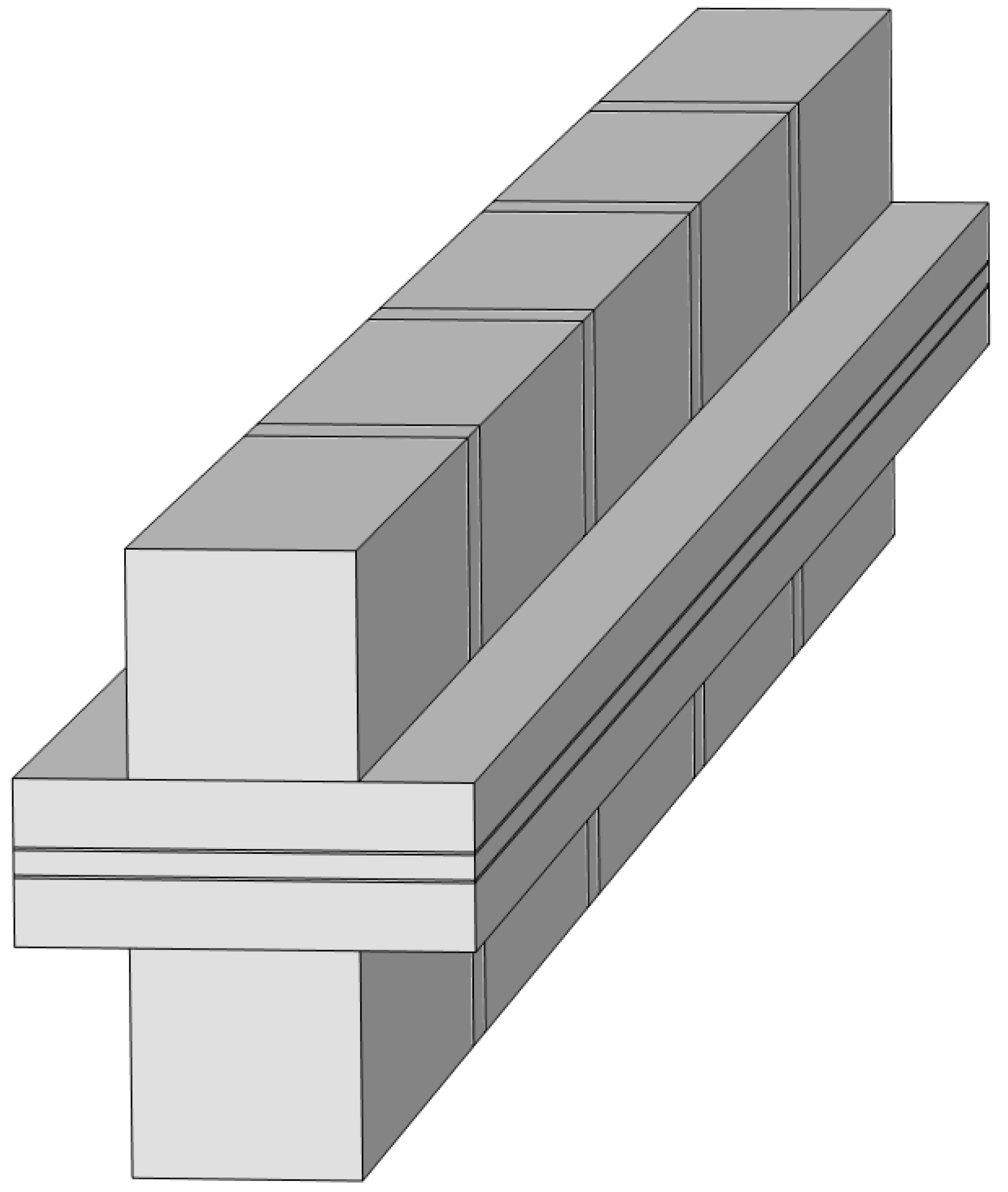

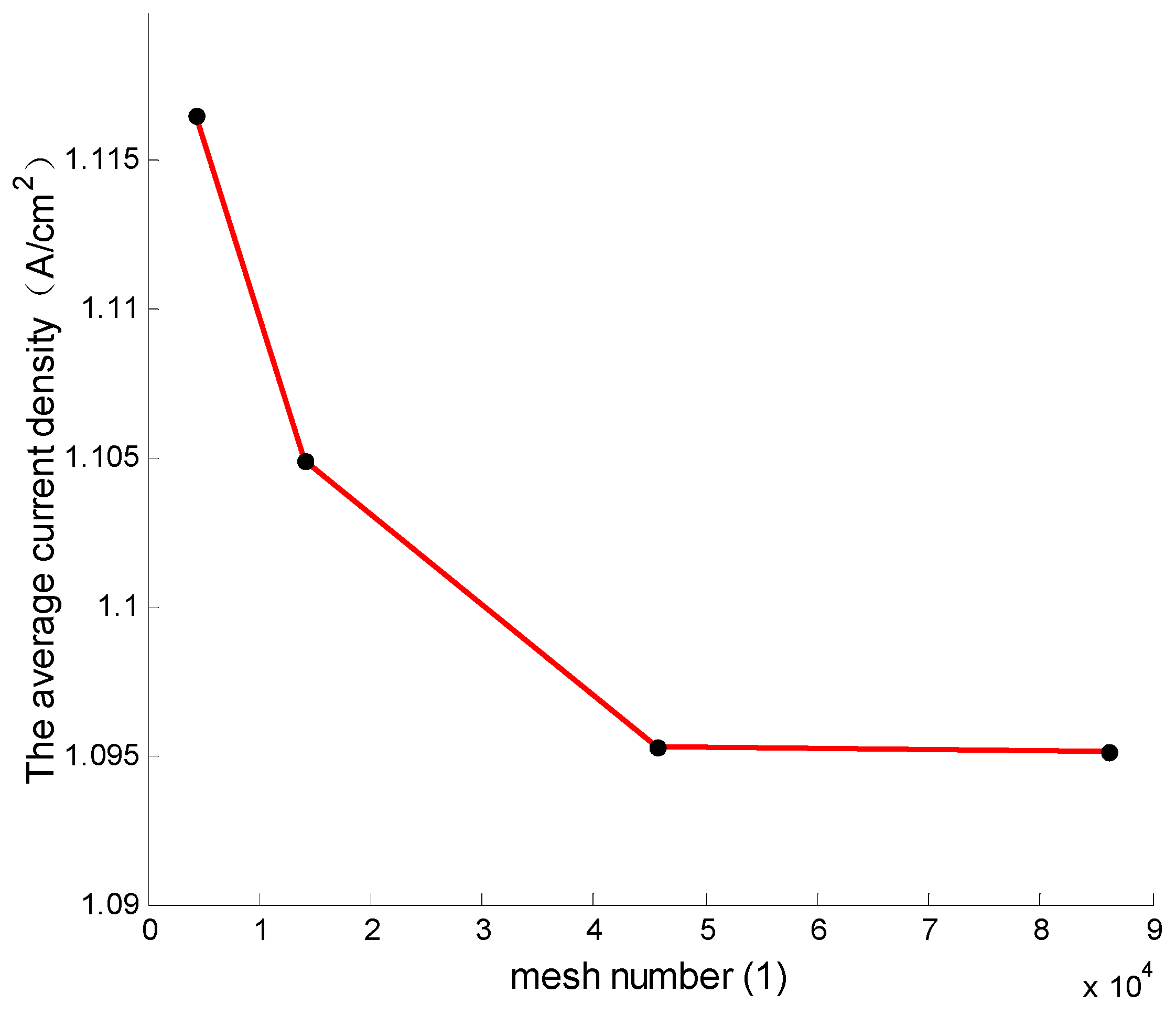



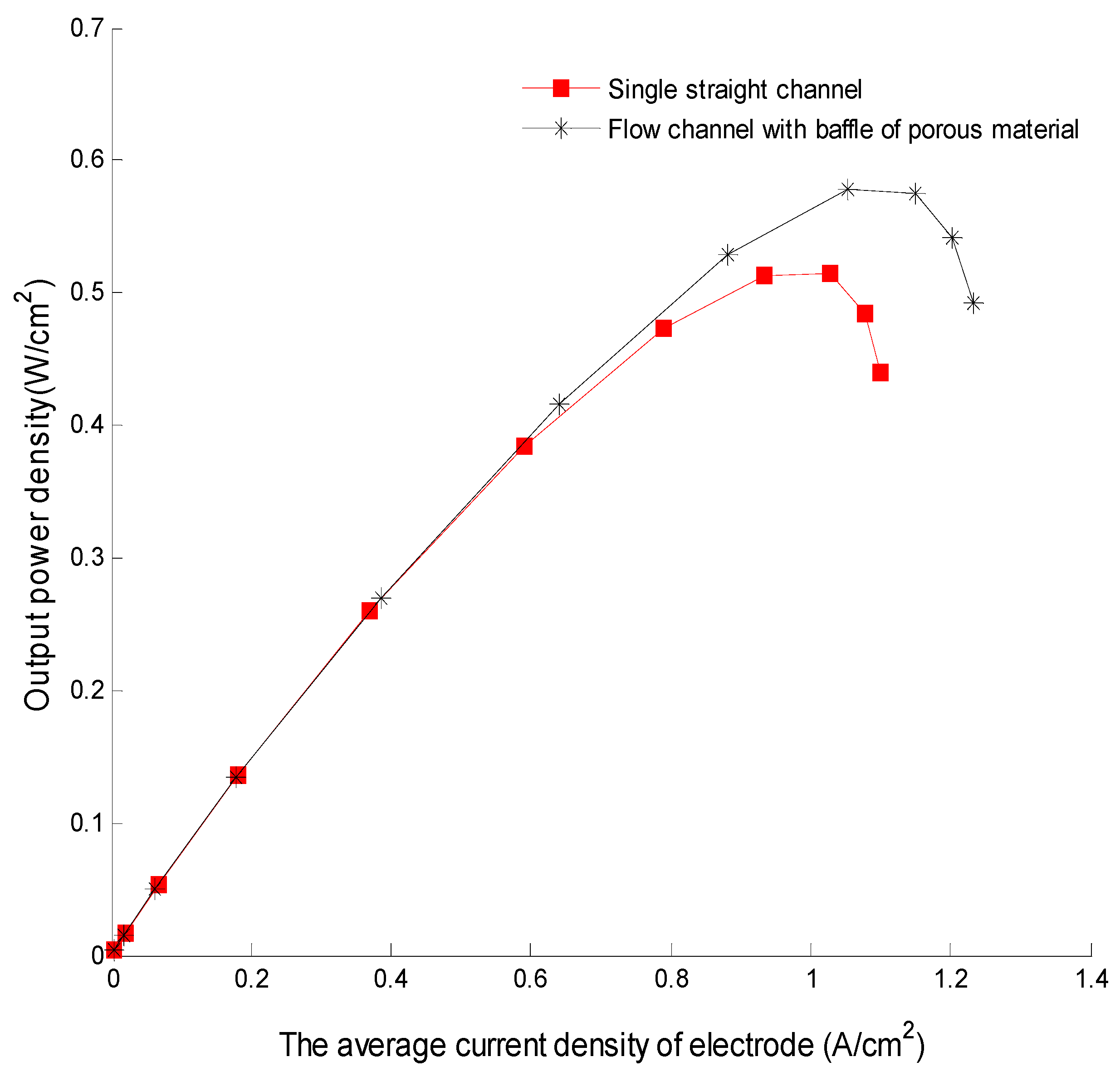
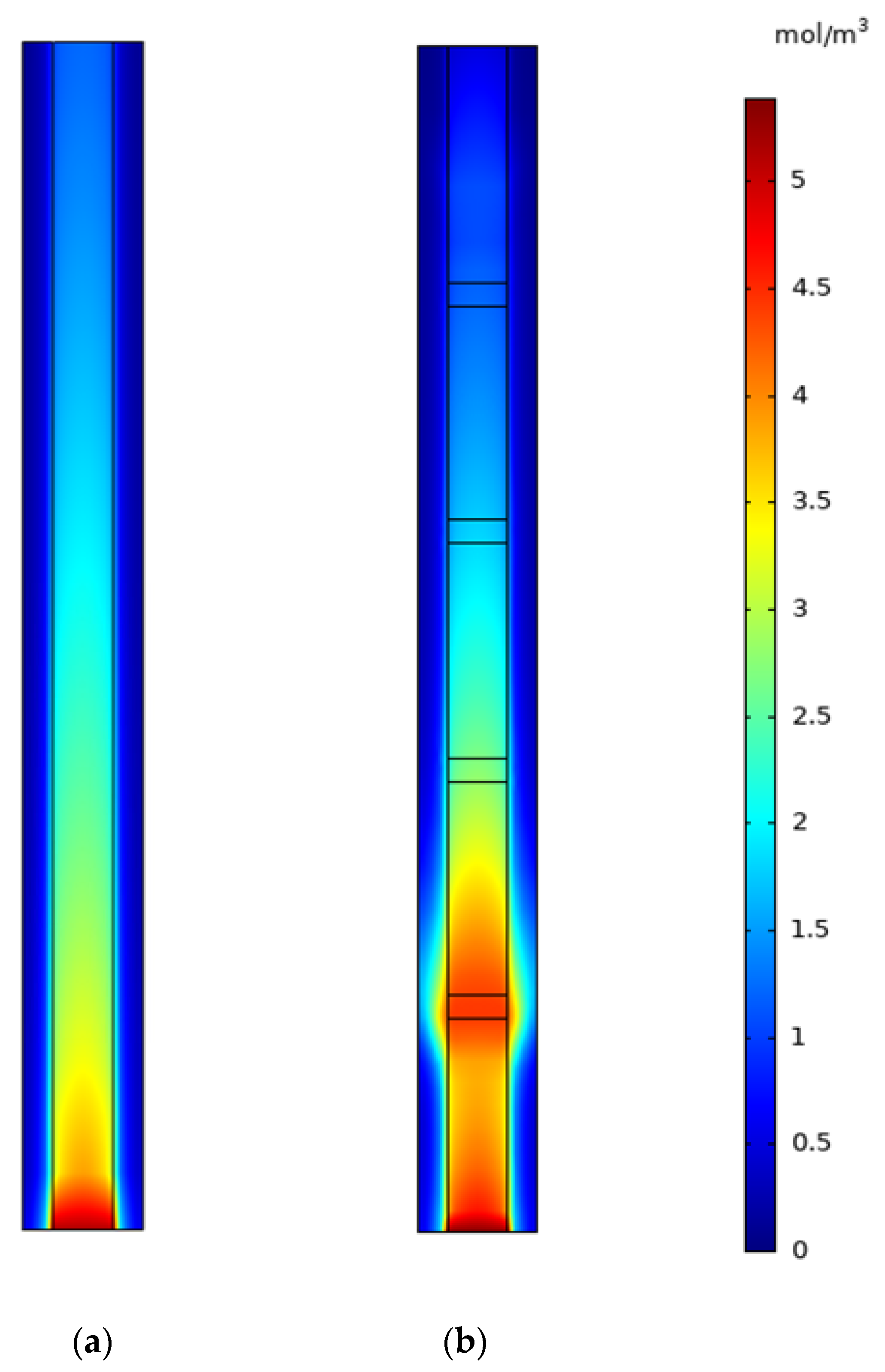
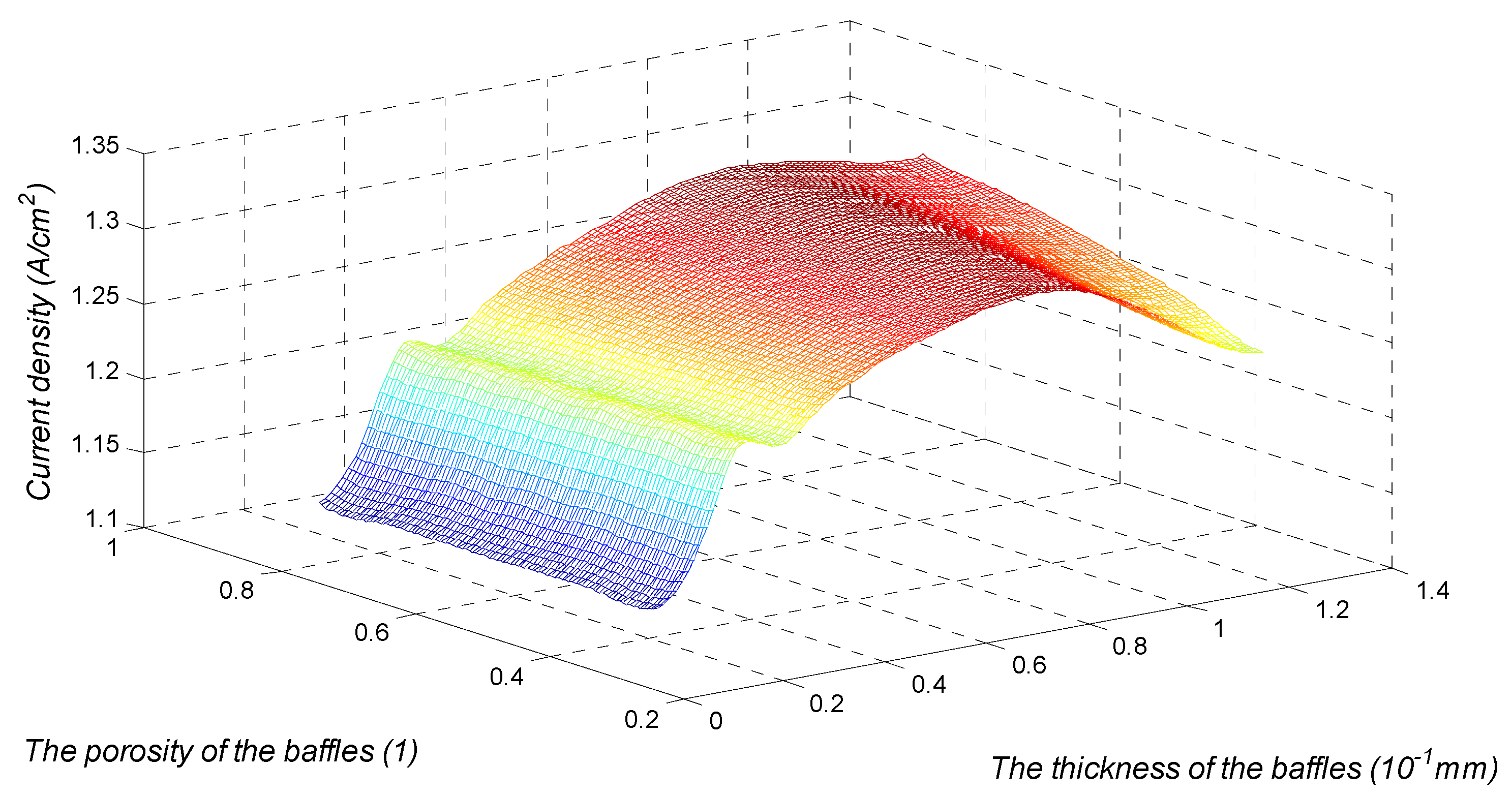

| Parameters | Value | Unit |
|---|---|---|
| 20 | mm | |
| 1 | mm | |
| 1 | mm | |
| 1 | mm | |
| 1 | atm | |
| Operating temperature (T) | 343.15 | K |
| Relative humidity of inlet flows | 100% | - |
| The anode excess coefficient | 3 | - |
| The cathode excess coefficient | 3 | - |
| 0.3 | mm | |
| 1.29 × 10−2 | mm | |
| Membrane thickness (Hmem) | 0.108 | mm |
| GDL porosity (Hch) | 0.4 | 1 |
| GDL permeability (Kgdl) | 1.78 × 10−11 | m2 |
| GDL electrical conductivity (σgdl) | 2000 | S/m |
| 0.4 | 1 | |
| CL permeability (Kcl) | 3.56 × 10−12 | m2 |
| 5000 | S/m | |
| 18.75 | S/m | |
| Relative humidity of inlet flows | 100% | - |
| Anode reference exchange current density | 56.4 | mol/m3 |
| Cathode reference exchange current density | 3.39 | mol/m3 |
| 9.15 × 10−5 | m2/s | |
| 2.82 × 10−5 | m2/s | |
| 2.2 × 10−5 | m2/s | |
| 2.56 × 10−5 | m2/s | |
| 1.1 | kg/mol | |
| 2.5 | - | |
| 1.4 | A/cm2 | |
| Faraday’s constant (F) | 96,487 | C/mol |
| 8.314 | J/mol K |
| Source Terms | Expression | Components |
|---|---|---|
| Mass source term (Sm) | Anode CL | |
| Cathode CL | ||
| Species source term (Si) | Anode CL | |
| Cathode CL | ||
| The water activity source term (Rv) | Cathode CL |
| Parameters | Value | Unit |
|---|---|---|
| 0.4 | mm | |
| 1 | mm | |
| 1 | mm | |
| Number of porous baffles | 4 | - |
| 0.8 | - |
Publisher’s Note: MDPI stays neutral with regard to jurisdictional claims in published maps and institutional affiliations. |
© 2021 by the authors. Licensee MDPI, Basel, Switzerland. This article is an open access article distributed under the terms and conditions of the Creative Commons Attribution (CC BY) license (https://creativecommons.org/licenses/by/4.0/).
Share and Cite
Chen, C.; Xuan, D.; Wu, M.; Liu, S.; Shen, Y. Performance and Parameter Sensitivity Analysis of the PEMFC Flow Channel with Porous Baffles. Appl. Sci. 2021, 11, 11942. https://doi.org/10.3390/app112411942
Chen C, Xuan D, Wu M, Liu S, Shen Y. Performance and Parameter Sensitivity Analysis of the PEMFC Flow Channel with Porous Baffles. Applied Sciences. 2021; 11(24):11942. https://doi.org/10.3390/app112411942
Chicago/Turabian StyleChen, Cong, Dongji Xuan, Mingge Wu, Shengnan Liu, and Yunde Shen. 2021. "Performance and Parameter Sensitivity Analysis of the PEMFC Flow Channel with Porous Baffles" Applied Sciences 11, no. 24: 11942. https://doi.org/10.3390/app112411942
APA StyleChen, C., Xuan, D., Wu, M., Liu, S., & Shen, Y. (2021). Performance and Parameter Sensitivity Analysis of the PEMFC Flow Channel with Porous Baffles. Applied Sciences, 11(24), 11942. https://doi.org/10.3390/app112411942







